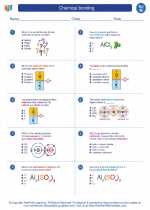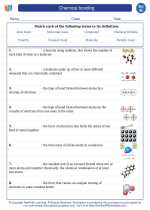Chemical Bonding
Chemical bonding is the process by which atoms are held together to form molecules and compounds. The different types of chemical bonds include ionic, covalent, and metallic bonds, each with its own unique characteristics and properties. Understanding chemical bonding is crucial in comprehending the behavior and properties of different substances.
Types of Chemical Bonds
- Ionic Bonds:
In ionic bonding, one or more electrons are transferred from one atom to another, resulting in the formation of positively and negatively charged ions. These ions are then attracted to each other through electrostatic forces, forming an ionic bond.
- Covalent Bonds:
Covalent bonding involves the sharing of electron pairs between atoms. This occurs when atoms have similar electronegativities and share electrons to achieve a more stable electron configuration.
- Metallic Bonds:
Metallic bonding occurs in metals, where the valence electrons are delocalized and free to move throughout the material, creating a "sea" of electrons that hold the metal ions together.
Properties of Chemical Bonds
The type of chemical bond present in a substance greatly influences its properties. For example, ionic compounds tend to have high melting and boiling points, while covalent compounds may have lower melting and boiling points. Understanding these properties is important for predicting the behavior of different substances in various chemical reactions.
Study Guide
To study chemical bonding effectively, consider the following steps:
- Understand the concept of valence electrons and how they determine the reactivity and bonding behavior of atoms.
- Learn about the Lewis dot structure and how it represents the valence electrons of atoms in a molecule.
- Practice identifying the type of chemical bond (ionic, covalent, or metallic) based on the electronegativities of the atoms involved.
- Explore the properties of substances with different types of chemical bonds and how these properties relate to the bonding forces present.
- Work on solving problems and exercises related to chemical bonding, such as predicting bond types, drawing Lewis structures, and understanding bond polarity.
By mastering the concepts and properties of chemical bonding, you will develop a solid foundation for understanding the behavior of substances in chemical reactions and the formation of various compounds.
[Chemical Bonding] Related Worksheets and Study Guides:
.◂Science Worksheets and Study Guides Eighth Grade. Chemical bonding

 Worksheet/Answer key
Worksheet/Answer key
 Worksheet/Answer key
Worksheet/Answer key
 Worksheet/Answer key
Worksheet/Answer key
 Vocabulary/Answer key
Vocabulary/Answer key
